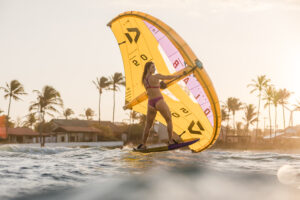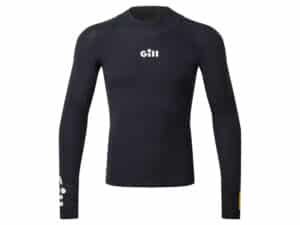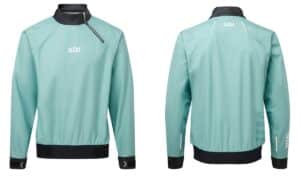There wasn’t much action for the First Substitute Flag (that would be the general recall flag) at the 2010 Melges 32 Worlds in San Francisco. With the Bay’s wicked tidal flow and an aggressive fleet, a week of relatively clean starts is a testament to the race committee’s ability to set a good line—and, as we now know, a welcome side effect of GPS-based race electronics that display distance to the line. The two most popular devices include the Rock Box (from Rock City Marine, www.rockcitymarine.com) and the new Velocitek ProStart (www.velocitek), which calculates and shows distance to the line (perpendicular, not actual sailing distance) once you ping both ends. It also doubles as countdown timer that automatically switches to showing real time speed over ground and heading once the countdown ends. The new display has only three buttons, and GPS data can be extracted for post-race analysis using the proprietary Velocitek software. Not all classes will allow such devices, so check your class rules. www.velocitek.com.
Another major shift among the sportboat crowd is the adoption of electric outboards: the benefits over standard outboards goes without saying: no gas, less weight, and no balancing acts over the transom to refill. Torqeedo’s latest offerings are much more powerful, and one of its new models for daysailers—the Torqeedo Travel 1003—is comparable to a 3-horsepower outboard and capable of pushing along boats up to 3,000 pounds at a steady, quiet clip. It’s claimed to be “fully fresh and saltwater-proof,” and to eliminate any uncertainty on running time, it has an integrated GPS that allows it to calculate and display battery-charge status, remaining range at current speed, speed over ground, and power consumption. When the lithium-manganese battery charge status reaches 30 percent, you get a audible warning, a which point you may want to bum a tow to the hoist from your gas-powered buddies. The Travel 1003 starts at $1,899, and you pick up all sorts of accessories, including a soft solar-panel charger. (www.torqeedo.com)
At the 2010 U.S. Sailboat Show in Annapolis, Harken introduced a reversible winch as well, available with its electric radial winches, and at the same time, revealed all sorts of new products, including, lightweight, low-profile below-deck furlers for small boats, updated traveler systems, and a whole new line of lightweight, all-composite blocks. The Harken Carbo T2 Blocks are Harken’s first block with no fasteners, rivets, or other metal parts, which Harken says makes them the lightest soft-attachment block they’ve ever designed. The weight savings may be good, but the best feature is the easy-to-install SK75 Dyneema loop attachment (included); the loop passes through the blockhead and wraps around an anchor post, so no splices or knots are required—very slick and versatile. They’re currently available in 40mm and 57 mm sizes. www.harken.com
Of the many gadgets associate editor Michael Lovett spotted at the fall boatshows, the one he says he coveted most was the Garmin GPSMAP 78sc. This handheld GPS unit combines the features of earlier models—a three-axis digital compass, waterproof construction, and buoyancy—with the significant upgrade of pre-installed BlueChart g2 coastal charts and a map-style display. In essence, says Lovett, the 78sc packs a full-featured GPS system—the kind you’d install at your nav station—into a handheld unit. While its 2.6-inch display can’t compete with a full-size screen, with the 78sc, Garmin dramatically narrows the gap between traditional chartplotters and handhelds. www.harken.com
At METS, the annual international marine tradeshow in Amsterdam, Seldén picked up top honors in the show’s coveted DAME awards program (Design Award METS) with the** Seldén Reversible Winch**. This groundbreaking new winch allows you to back a line off the winch without having to take it out of the self-tailer. The backwind is engaged when the push button in the handle is pressed. There is an obvious safety advantage with the reversible winch concept (less line handling under load), but there’s also a potential benefit to the racer: easing and trimming the jib in small increments could be faster because the line doesn’t need to be removed from the self-tailer, and more repeatable (i.e., a “burp” becomes precisely a quarter turn of the handle). www.seldenmast.com
It’s been a long time since we’ve seen anything new for the performance sailors from Yale Cordage, but after four years of developing its Ph.D. single-braid line, Yale came out swinging (rope that is) at the fall boatshows. The Yale Cordage Ph.D. is, they claim, a “game changing” departure from the standard double-braid core and jacket combination. What they’ve come up with is a clever way of getting strength (from bundled, pre-stretched Spectra S1000) interwoven with a 12-strand polyester single braid. What does this new approach mean for the racing sailor? For starters, there’s no cover to strip and discard, and you can practically put in an eye splice with your eyes closed. Open the weave, insert the fid (Tip: if you don’t’ have a fid, dip the tail in epoxy to harden it), milk it through, make your eye, and trim. Tom Yale will challenge you to do it in 30 seconds or less. The other benefits of the Ph.D. single braid, says Yale, are less bulk, less weight, fewer hockles, and a soft touch, making these ideal for jib sheets and main sheets. Available in a range of diameters from 1/4″ to 1/2″ at $.98 to $3.00, respectively, a foot. www.yalecordage.com









